Nothing could possibly go wrong
Key Points:
• We think if interest rates continue to be normalised and economic growth holds up, corporate earnings next year should be healthy.
• In this environment we could see a narrowing of returns across market sectors as more expensive areas of the market grow into their multiple.
• The key risks to this outlook are a negative policy mix from the Trump White House, the (falling) risk of a recession in the US, sticky inflation just above target (which stymies further rate cuts), disappointing tech earnings, and the risk that bond investors demand higher yields to compensate for unsustainable fiscal trajectories.
Around the end of each year, we like to dust off the Magic 8 Ball and write about what the next year may hold. All said and done, 2024 has so far been relatively benign. There were a few market highlights, including a relatively spectacular unwinding of a Japanese Yen carry trade, the triggering of the Sahm Rule, and the announcement of long-awaited Chinese stimulus, but in the aggregate, not much has happened. The feared US recession failed to eventuate, inflation continued its lumpy progress back towards target and most major central banks began the process of reducing interest rates. Equity investors were rewarded in this environment, with global equities up more than 20% calendar year to date. As has been a recurring theme, performance was led by large cap US technology stocks. However, other equity markets also posted solid performance. With interest rates generally rising through 2024, fixed interest investors didn’t fare as well (though floating rate credit outperformed fixed rate investments).
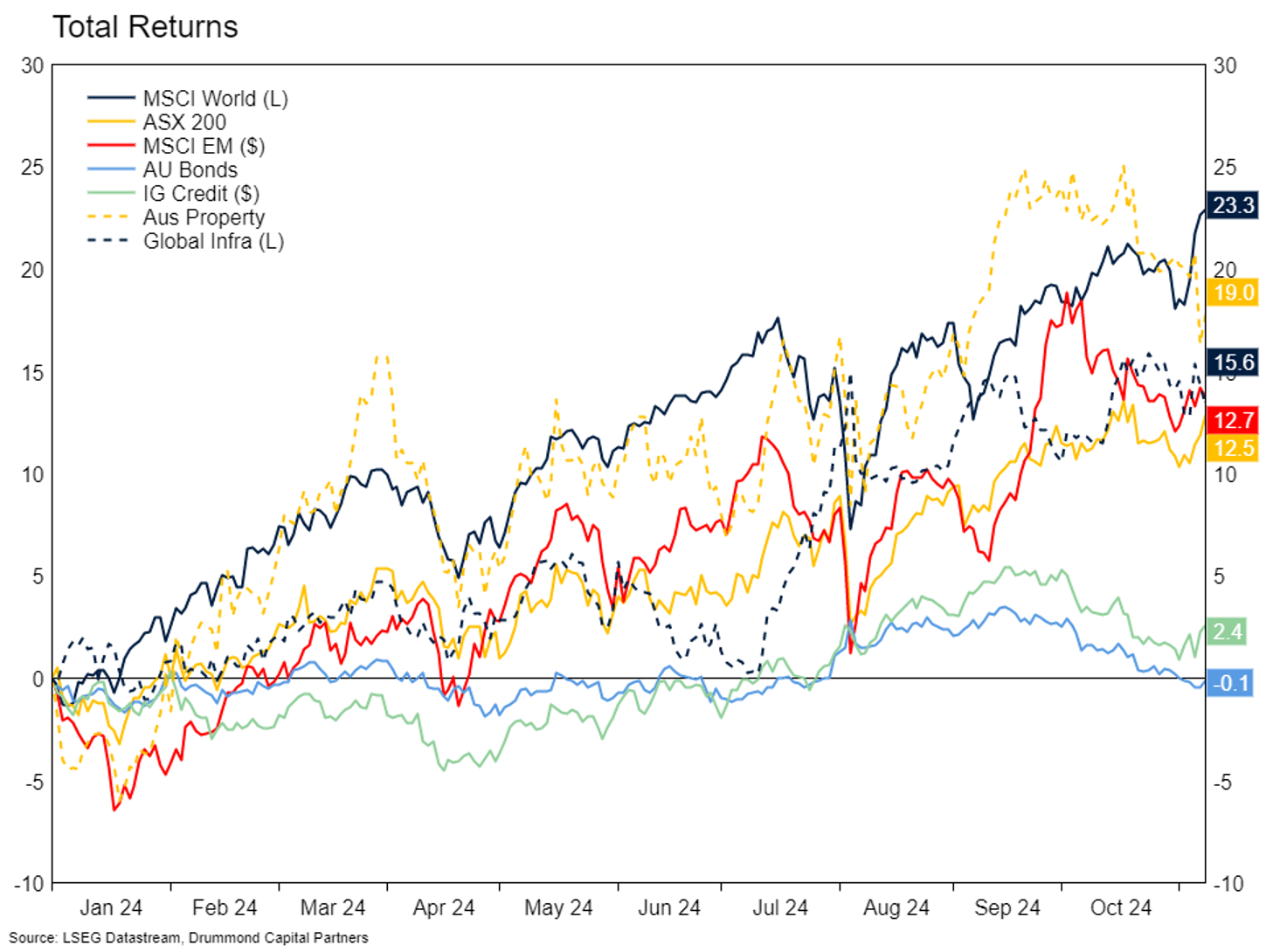
Will 2025 be any different? Below, we outline our central case for the year ahead and some key themes which risk derailing it.
The Central Case
Perhaps this will be a case of famous last words or tempting fate, but after a number of years of considerable macroeconomic uncertainty, 2025 is shaping up to be “normal”. In 2020, Covid dominated forecasts. In 2021, the impact of lockdowns and the legacy of gargantuan fiscal stimulus were key swing factors to the outlook. In 2022, the world faced generationally high inflation and interest rate hikes. In 2023 and 2024, the focus was on whether those rate hikes would lead to a recession. Next year, there is nothing that stands out as an obvious problem – though there are risks (more on this later). With inflation close to target, and expected to continue to moderate, there is no reason for central banks to keep monetary policy restrictive. As a result, we think they will continue on the path of easing next year, reducing policy rates towards their estimates of neutral. This is broadly in line with current market consensus (see below). Mechanically, this reduces the risk of a recession and should begin to support economic growth (or at least put a floor under it) in the second half of 2025.
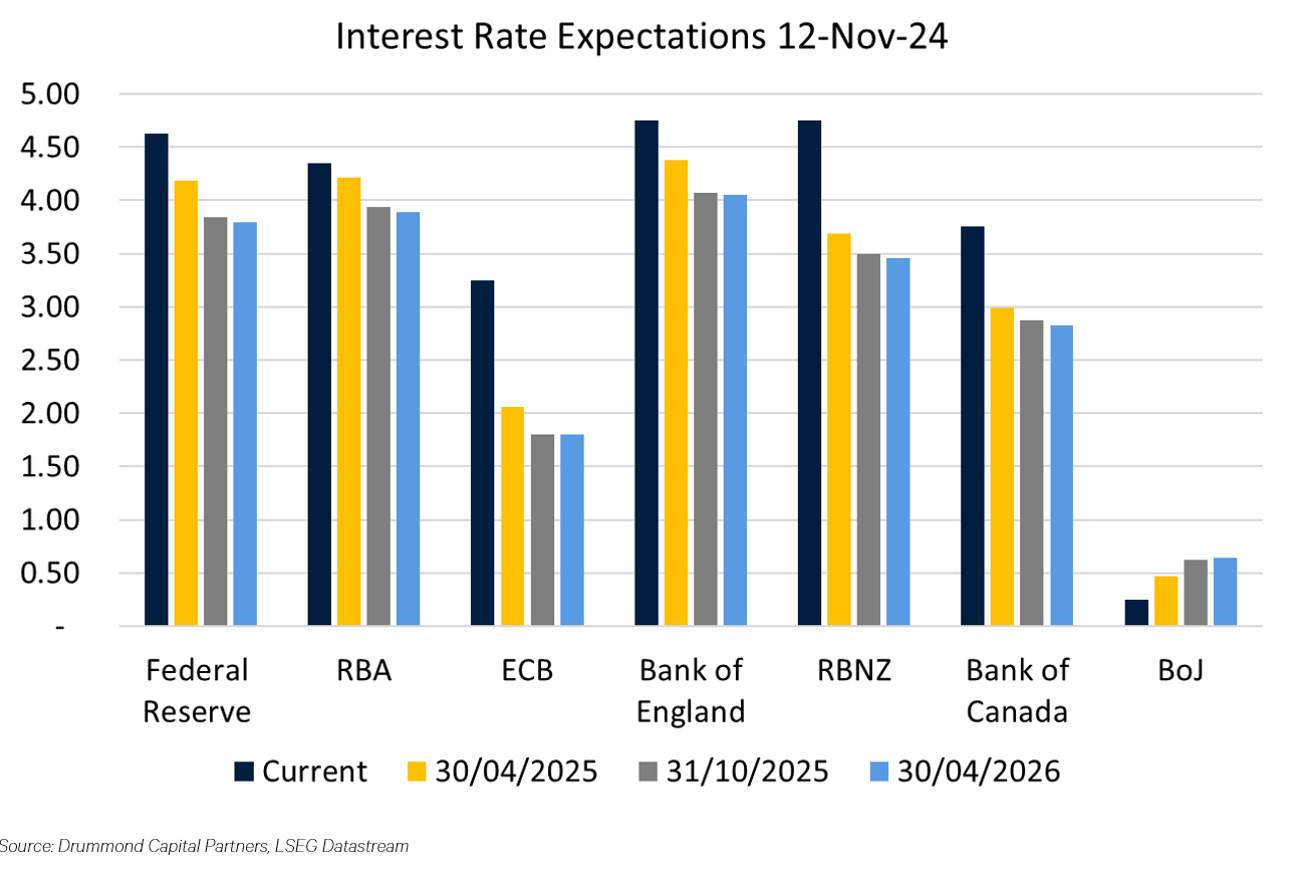
This relatively benign outlook for the economy, inflation and central bank interest rates should keep long term interest rates generally anchored around current levels, although we could see some more risk premium baked into yields due to the high government debt loads (more on this below). Regardless, there would be nothing exceptional about a US 10-year bond yield with a 5% handle with a Federal Funds Rate at 3.75% - that would be something approximating a normal yield curve. As long as the journey to that place is relatively smooth, equity markets should handle that discount rate repricing well.
With short-term interest rates falling, a normalisation in wage growth, and economic growth relatively healthy, there is little to stop reasonable growth in corporate profits. Indeed, consensus expects around 10% earnings growth over the next 12 months for global equities as a whole. While consensus is normally overly optimistic, high single digits wouldn’t be a stretch and is broadly in line with the long run average outcome. However, earnings growth is only part of the equation. Valuations are lofty for large cap indexes – indeed it would be reasonable to argue that they are fully pricing in the benign (or optimistic, depending on your viewpoint) scenario outlined above. The S&P 500 and ASX 200 indexes are both around 1.5 standard deviations expensive (or about as expensive as they get outside of exceptional circumstances). However, small and mid-cap companies in the US, emerging markets and developed markets ex USA and Australia are trading at much lower multiples – so there are pockets of value if these markets can deliver earnings.
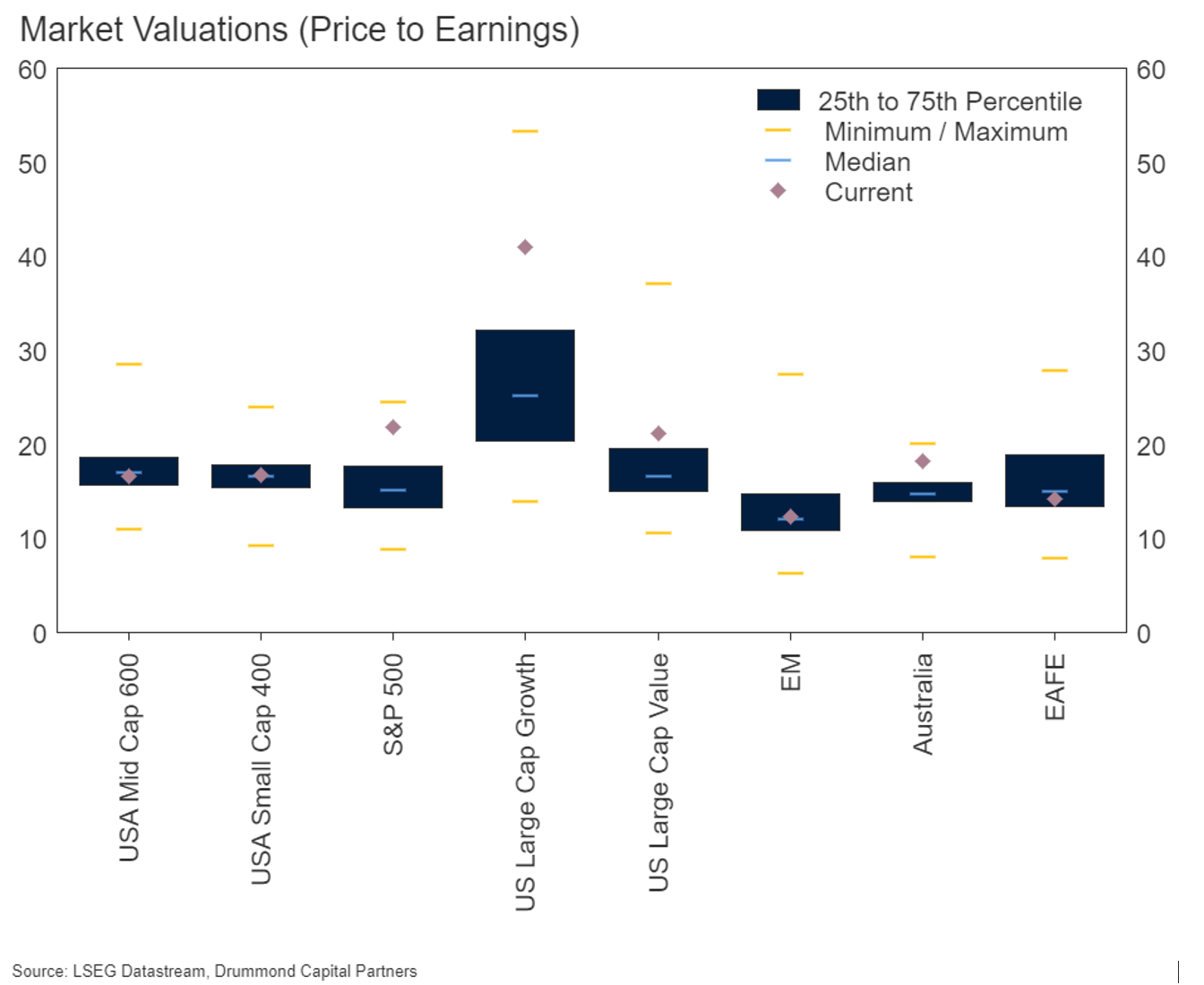
We wouldn’t be surprised to see some rotation over the next year, or at least a narrowing in total return differentials between these various markets. We think US mega-cap technology companies will continue to deliver excess earnings growth, but this is needed to grow into their valuations. Everything else will likely see lower earnings growth than tech, but won’t face the same valuation headwinds.
If all of the above sounds too good to be true, or alternatively, is putting you to sleep due to lack of excitement, then bear with us and read on. Below, we outline the themes we think have a reasonable chance of derailing this central case in the year ahead.
Surprise, Recession!
Perhaps when everyone finally stops worrying about the recession is when it will finally arrive. To the extent that there is a normal economic cycle (there isn’t, but let’s pretend), the chart below shows that so far, everything is going to plan (if the plan is for a recession). Normally, interest rates rise, then central banks pause for a while. Then the unemployment rate starts rising (yellow line falling), central banks begin to cut interest rates, and we get a recession. So far, we are four fifths of the way through this process in the US. We still don’t think this is the central case, but we will be a lot more comfortable finally putting this risk to bed in six months’ time if it hasn’t eventuated.
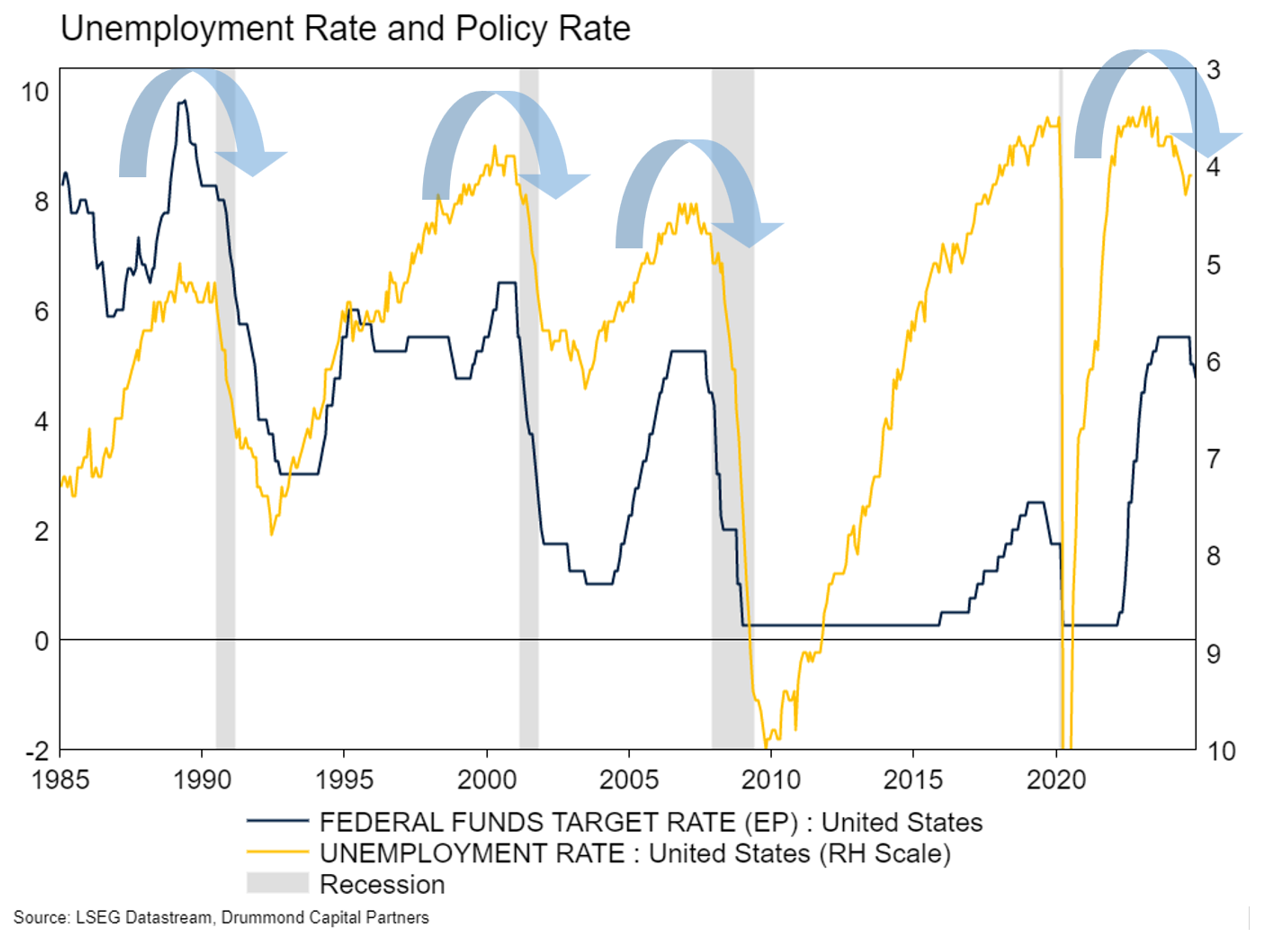
White House Chaos
President Elect Trump represents the biggest risk to the benign outlook. Our central case rests on a policy agenda from the Trump White House which broadly mimics in large part his first Presidency. We expect tax cuts and deregulation, which should be positive for equity markets and also relatively easy to get through Congress. We also expect some new tariffs and reduction in immigration, which should be negative for equity markets. But on net, we see the equity market impact of this as roughly balanced and the bond market impact as negative (given prospects for higher inflation).
However, the past is not necessarily prologue and we could end up with wildly different outcomes than this. If Trump neglects the tax cuts and deregulation aspects of his agenda and manages to implement his tariff and immigration campaign proposals fully, we think this would be a significant negative shock for equity markets. The impact would be highly inflationary and stymie economic growth. Otherwise, Trump is a wild card in general, there is no telling what he will actually try and do while in office.
Fiscal Dominance
The giant pink elephant in the room is in the chart below. The US, alongside most other developed countries, is on a clearly unsustainable long-term fiscal path. A good part of the reason why interest rate hikes in 2022 and 2023 didn’t lead to a recession in the US was leftover household Covid stimulus savings and a widening in the US budget deficit (a good deal of which was related to IRA and CHIPs Acts stimulus spending). With no plan to actually reduce the deficit (Trump argues that his tax cuts will be paid for by tariff receipts, but no credible policy analysis suggests that this will be the case), the expectation is that the US debt pile will continue to grow indefinitely. The trajectory is worsened by an ageing population.
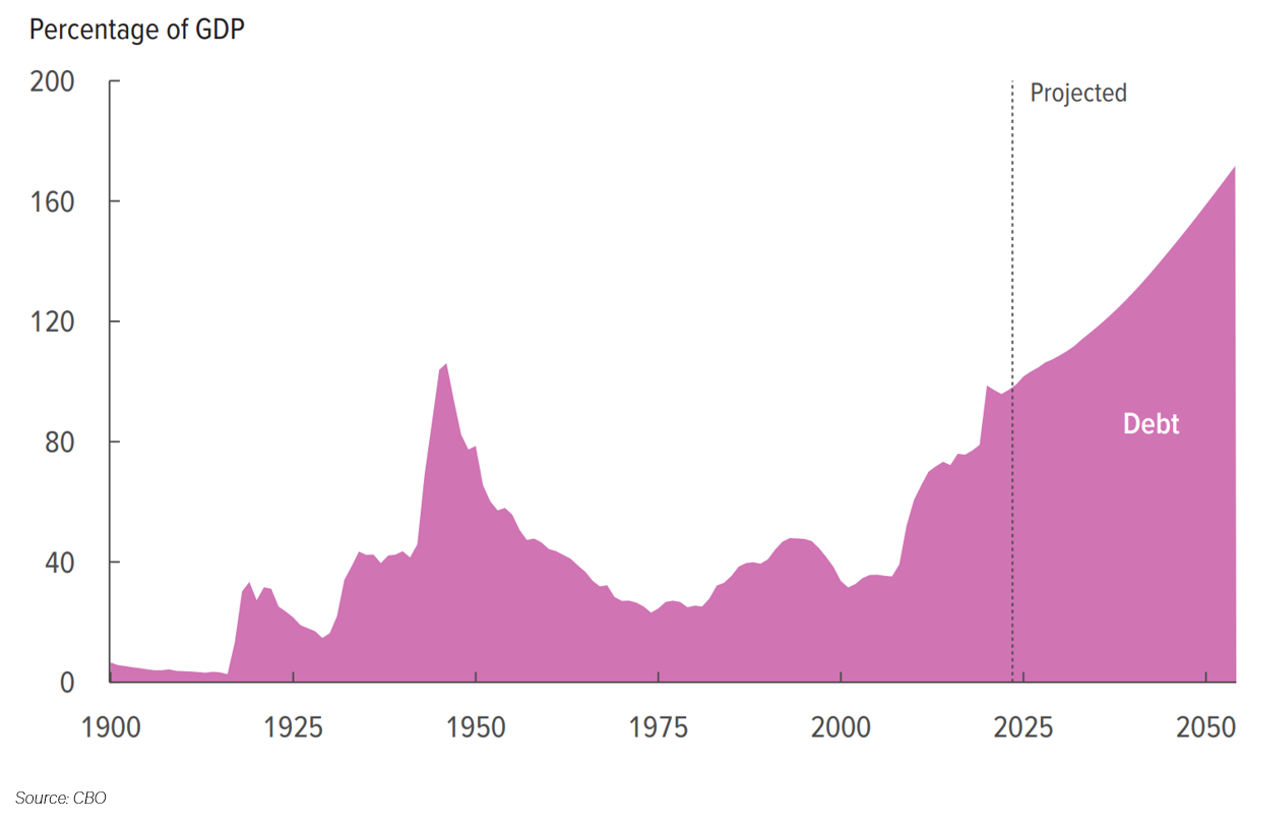
At some point investors should demand compensation for providing this financing. With Federal Reserve independence under the greatest threat in decades from the Trump Presidency, potentially this demand is made as early as next year.
No landing
A less bombastic scenario, but still one to be mindful of is the risk of no landing, or at least a bumpy one. While inflation is close to target in most major economies, it is not a fait accompli that the last little bit of normalisation occurs smoothly. Labour markets are still tight, economic growth is around trend, and we have now entered a policy easing cycle. If inflation stays sticky a little bit above target, investors will face an uncomfortable dilemma. Will central banks pause their easing cycles earlier than originally thought? Surely such a scenario would be difficult to stomach for equity markets priced to perfection.
Tide Turns on Tech
Global equity returns have been dominated by mega-cap technology companies in recent years, with good reason. They have delivered the strongest earnings growth (light blue line below) and the best earnings resilience in times of stress. Indeed, the earnings of almost everything except US large cap growth equities has trended sideways to lower over the past two years. As noted above, this has driven multiples for these market darlings, and the broader index of which they constitute a large weight, to lofty heights.
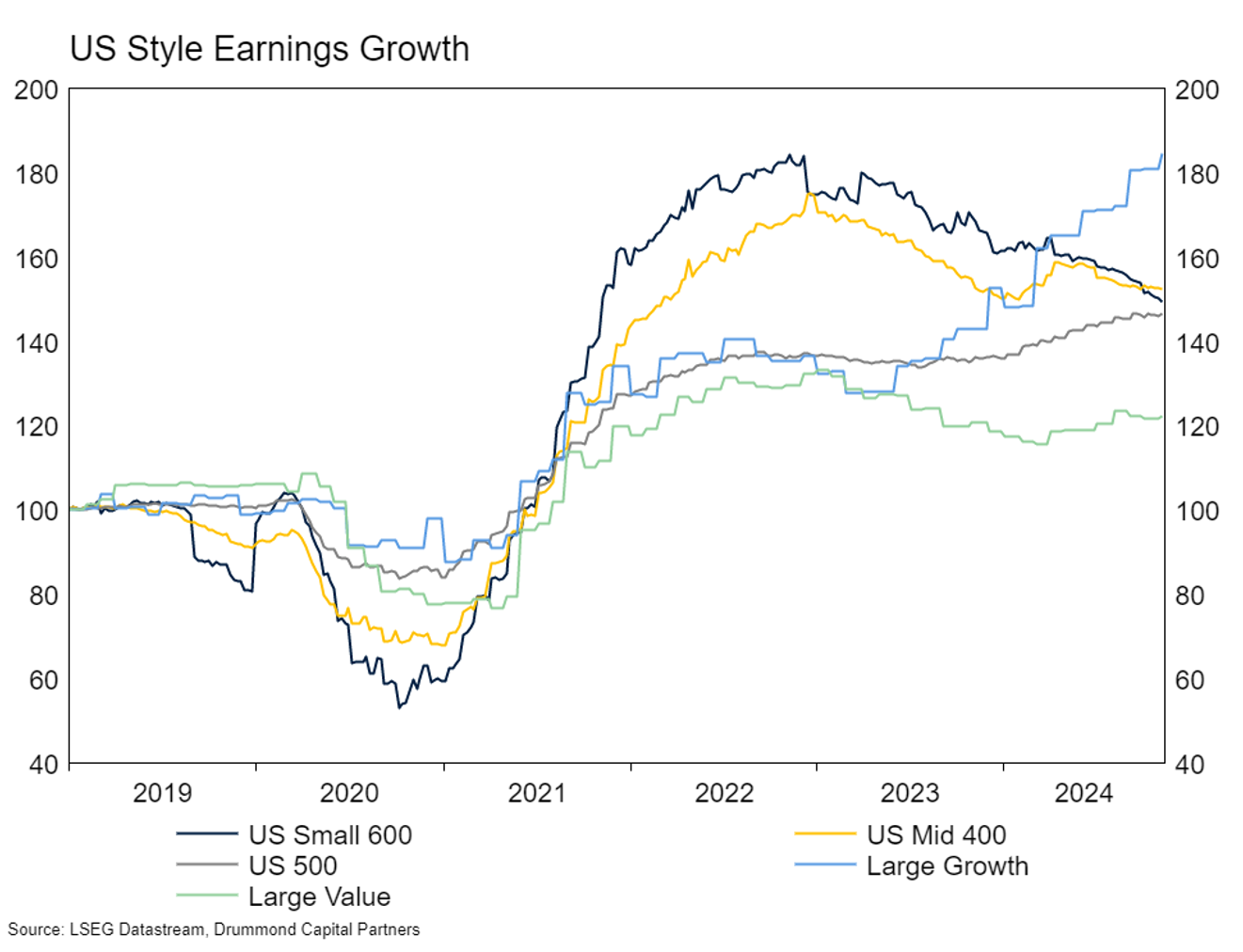
Market expectations for earnings growth in these companies is very high and their sheer size implies that they will not be able to grow as quickly in the future as they have in the past. In line with this, we could see much more mixed market reactions to earnings seasons in the US than we have in the recent past. When your multiple is priced for perfection, you can’t afford to disappoint the market with anything less than exceptional earnings growth.
Portfolio Positioning
Growth asset exposure in our portfolios remains neutral and the portfolios also remain strongly underweight government bonds. For now, we think that balances the positive central case with high valuations and the risk that the central case gets derailed. Over the next few months, we will have a clearer indication of Trump’s legislative agenda, as well as more economic data points confirming or denying the risk of recession. We expect that as these factors in particular evolve, the portfolio will be adjusted accordingly.

